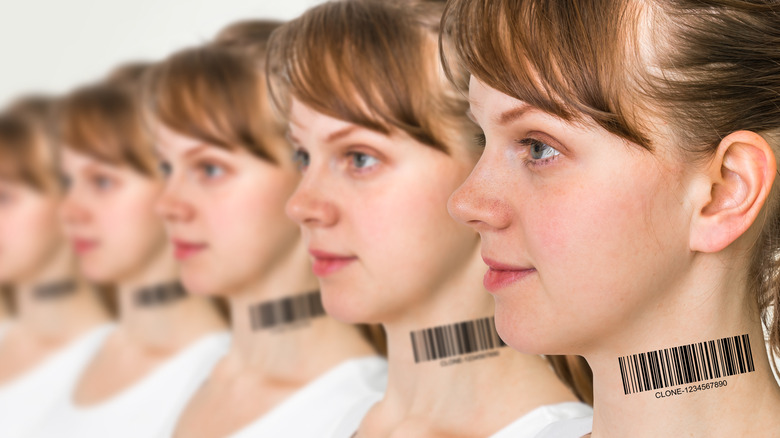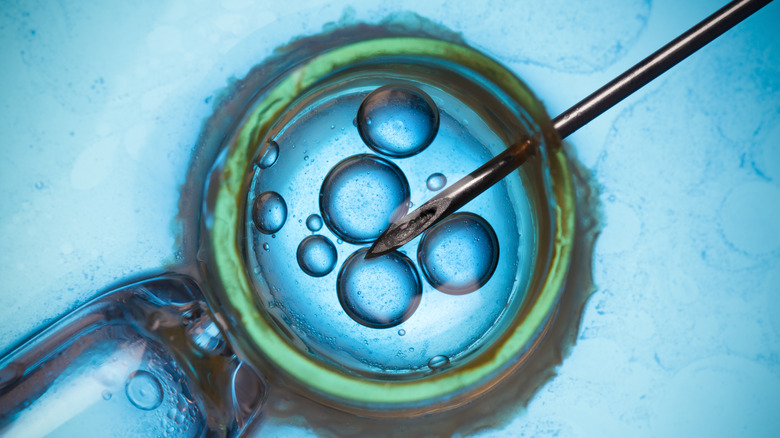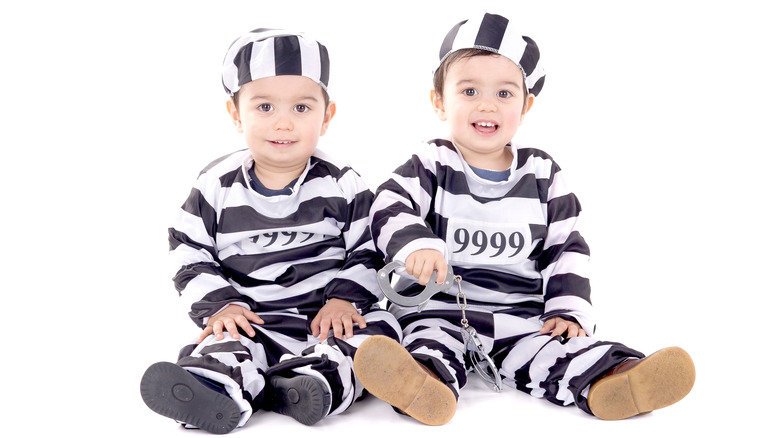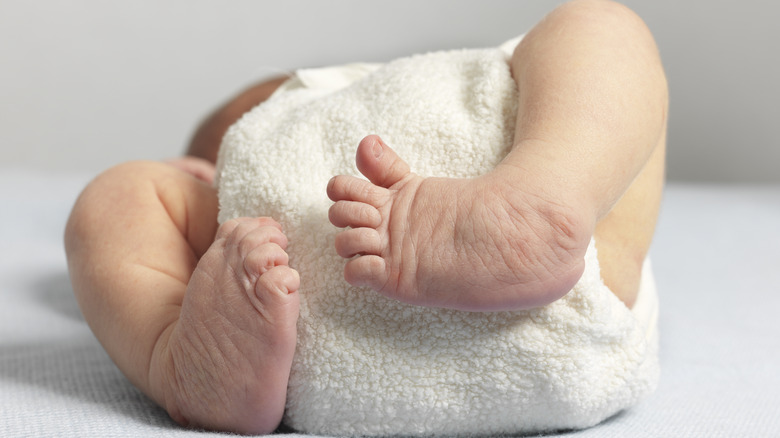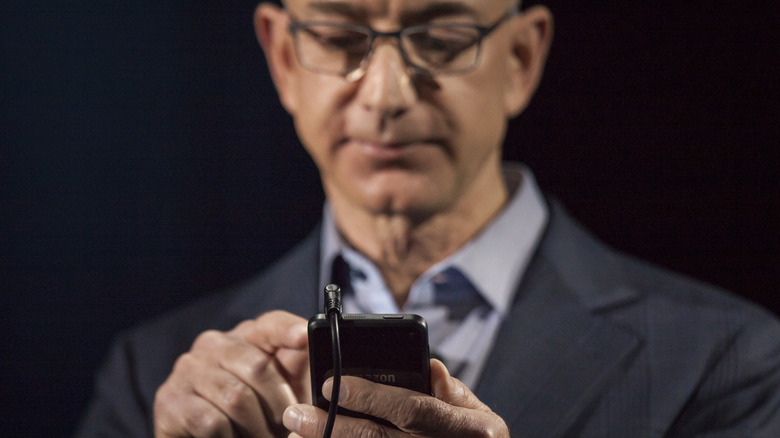What Would Really Happen If You Cloned Yourself?
Cloning turns out to be more complicated than finding an old mosquito trapped in some amber. Human cloning, specifically, is so hard, to the best of anyone's knowledge, this sci-fi feat has never actually been achieved.
Partly, it's an issue of technology. Humans are complex and sensitive creatures, right down to our DNA. But more pertinently, perhaps, considering animal cloning began in the 1990s, human cloning is a thorny political issue –- and not a particularly divisive one. As of 2021, 86% of Americans surveyed in a Gallup poll agreed human cloning is "morally wrong." And that number has only grown over the years. Few issues share this level of consensus — and scientists largely agree. In 2003, 60 different scientific academies worldwide called for a United Nations ban on human cloning, according to The Guardian.
Despite the challenges, explicit laws against human cloning are somewhat scant. Many also believe the technology is nearly within grasp. So you can forget those old canards like, "two identical objects cannot occupy the same space." You definitely wouldn't destroy the universe by hugging your clone. Human cloning is just an engineering challenge, so despite public opinion, it's probably inevitable.
But a crucial thing to keep in mind as you mull doubling your DNA, unlike the full-grown "replicants" of "Blade Runner" and similar scenarios, a human clone would almost certainly start as an embryo. Here's what would really happen if you cloned yourself.
You'd win a very unethical science fair
Cloning humans isn't just hard, it's so far been impossible, largely because of our uniquely designed sex cells. There's even a weird difference in the degree of difficulty in cloning seemingly similar animals. "I think no one realized how hard cloning would be in some species though relatively easy in others," Stanford bioethicist Hank Greely told Insider. "Cats: easy; dogs: hard; mice: easy; rats: hard; humans and other primates: very hard."
Various scientists have been claiming to have cracked the human clone code since the late '90s, and yet the facts just don't back up these assertions, according to the NIH's National Human Genome Research Institute.
Cloning yourself or other genetically related primates would most likely involve removing a donor egg's nucleus to be replaced with a custom nucleus from an adult cell. But in primate eggs (people are primates), a pair of proteins essential for cell division called "spindle proteins" are so close together that messing with this sensitive cell removes these essential components for growth. This is a real corker of a problem. And since big pharma has not expressed much commercial interest in human cloning, according to bioethicist George Annas of Boston University, per Insider, funding hasn't scaled with the challenges. In short, your efforts to clone yourself might come with scientific prestige, public condemnation, and possible jail time, but not necessarily millions.
Your clone probably won't look like you
Clones aren't exact copies in practice. This fact is not at all fun and irritatingly flies in the face of the word clone. For one, your clone would start as a baby, not spring from a 3D printer for people. Depending on your age, you might be pretty old by the time your copy took shape.
The main issue though is called gene expression. Matching DNA doesn't mean matching development. Anyone with an "identical" twin knows the term is a bit of a misnomer. There are always little differences. That's because the environment "plays a big role in how an organism turns out," according to the NIH's National Human Genome Research Institute. Genes are like light switches. They can either be on or off. Lots of things can flip these switches — or not flip them. The NIH points out the first cat to be cloned had a coat that was very different from her genetically identical mother, so the two didn't resemble each other at all.
If your plan is to clone yourself for trickery like Christian Bale in "The Prestige," you might need to tap into Christopher Nolan's larger oeuvre and think bigger. Perhaps if you implanted your clone embryo into an exact copy of your own past, that cloned universe would express genes just like it went down in you. But also, since that's not a thing, maybe not. Who knows.
You could go to jail
The United States has no explicit federal laws against human cloning, according to The New Atlantis. Florida, Delaware, Oregon, Texas, Washington, and others have no state laws against human copy-pasting either. Still other states like California have made exemptions for cloning research as long as a baby is not produced. Arkansas, Michigan, and several others, however, have prohibited all cloning completely. So unless you're careful about location, you and your clone could be in double trouble — though in the event you were sentenced to prison, maybe there's somebody who could take your place.
Federal legislation to ban human clones has been abortively attempted many times, some with laughably low civil penalties like a $5,000 fine — unlikely to dissuade even a high-concept Doublemint gum ad. This power vacuum left the Food and Drug Administration (FDA) in charge, which simply asserted authority in 1998, making two simple decrees: If you want to make a clone, you need FDA permission; and also, the answer is no. They cited "major unresolved safety questions," as per The New Atlantis.
Internationally, in 2019 the Chinese government sentenced the first scientist to create a genetically engineered baby to three years in prison, according to STAT. He Jiankui used CRISPR (DNA editing) technology to edit the DNA of twins (aka natural clones) in order to create HIV immunity. Despite the seemingly laudable aim, a Chinese court ruled the experiment was "in the pursuit of personal fame and gain." Many scientists also denounced the experiment. Three children were born of these cloning-adjacent efforts.
Your clone might drop dead
Don't count on clone labor anytime soon because even after you've successfully cracked the genomic code, persuaded the public it's all good, and evaded various laws, very likely, your double would have some health trouble.
The first mammalian clone formed from an adult cell was Dolly the sheep, according to Scientific American. This was huge news in 1996 and seemed to portend a brave new world. But Dolly died young, at only 6 years old, roughly middle-aged for a sheep. She had early-onset osteoarthritis, and researchers at the time thought cloning might've caused it. However, a later study said this conclusion was "unfounded" even though Dolly had other health issues, and there were many Dolly clones, most of them duds.
Large mammals, in general, have proven difficult to duplicate. A Massachusetts company tried to clone an endangered wild Asian ox in 2001. It died of dysentery in two days, according to Science. Two years later they took DNA from a long-dead "Banteng," and implanted the deceased animal's life force into surrogate cows. In 30 tries, only two Bantengs came to term. One was healthy, the other was born double the normal birth weight and was euthanized. But even with one success, experts remained skeptical. "I strongly disagree that these clones are 'normal' just because they survive the postnatal period and appear normal," Rudolf Jaenisch of MIT told Science, pointing out many clones who initially seem fine develop serious health issues and die prematurely.
Your clone might be deformed
Even if your likely illegal clone didn't immediately drop dead and wasn't chased down by a torch-wielding mob of Americans who've already decried such experiments, this futuristic little Frankenstein might be similarly monstrous.
"The cloning process seemed to have interfered with the normal genetic functioning," explained a 1999 study of a deformed calf clone, published in The Lancet (via the National Center for Biotechnology Information). It was already known clones tended to die shortly before or just after birth, but researchers also noted the process is likely to cause long-term abnormalities. This fact "should be taken into account in debates on reproductive cloning in human beings," warned study lead Dr. Jean-Paul Renard.
The unfortunate calf clone died at seven weeks from severe anemia, which is an iron deficiency. The scientists discovered upon autopsy the animal's lymphatic system had almost completely failed to develop. In other studies, mice that initially appeared normal suddenly "grew grotesquely fat," according to The New York Times. Researchers told the Times in 2001 it appeared even though cloning does copy DNA exactly, gene expression is directly affected, with "random errors" that can emerge at any time. "With cloning, you are asking an egg to reprogram in minutes or, at most, in hours,” MIT researcher Dr. Rudolph Jaenisch explained. A natural process that usually takes months or years is so condensed that copying errors simply pile up. So, even if your clone survived infancy and briefly thrived, things could go terribly wrong at any time.
Your clone could destroy humanity
Your clone is unlikely to develop uber-strength or the megalomaniacal genius necessary to take over the world — though, given the likelihood of massive genetic mutations, anything is possible. The real threat your clone could possibly pose to humanity is that its altered DNA could enter the human germline, adversely afflicting your descendants in perpetuity.
A germline mutation is when a change in your body's sex cell, the sperm or egg, becomes a part of the DNA of one's offspring, according to the National Cancer Institute. As discussed, since cloning people has proven difficult because of how human sex cells are constructed, it's conceivable gene-editing technology like CRISPR could be used in your quest for a clone by altering this cell to make it easier to work with. But meddling here could cause genetic changes to your clone that might be passed on to your clone's offspring too, according to Ethics, Medicine and Public Health.
Thus, if your experiments in self-actualization introduced some catastrophic error — say a mutation for antisocial and psychopathic personality traits — this genetic gambit could become a permanent feature of many future humans. If you don't think one bad seed could possibly cause much damage, consider that Mongol Emperor Ghenkis Khan did so much pillaging, today, one in 200 men on earth is a direct descendant of this brutally effective warlord, according to Discover.
You may have to make two clones, not one
Clones often come in clumps. Depending on the methodology used, making a clone may require implanting two clones into a female womb, much like how monozygotic twins are formed naturally, as per Discover.
"Gene cloning" is all the rage these days, maybe because it doesn't involve creating a breathing being with sad eyes that will make you question your choices. This more humane process involves taking a segment of DNA and placing it inside a bacterial cell's DNA, which acts as a natural little replication factory, according to Discover. This technique has helped develop vaccines and antigen tests, like the one that detects COVID-19.
However, the way Dolly the sheep and other mammals were made was via reproductive cloning. The most advanced approach is called somatic cell nuclear transfer, or SCNT. It uses an electrical current to fuse an adult sperm cell with an egg that's had its nucleus removed. But since removing a human nucleus from an egg has proved so difficult to do without stripping away the cell's power to grow, you and your clone may need to rely on an older method wherein a fertilized embryo is simply split (like in identical twins) and both are implanted into a surrogate womb. Often in science, relying more on mother nature can help you get to your goal. But that also might mean your clone will have a creepy clone of its own.
You wouldn't have to clone your entire body
There's a concept in the clone world called therapeutic cloning that avoids some of the deeper ethical concerns in which you could simply clone body parts, a la carte.
This technique involves grabbing stem cells, which according to Discover, can be derived from a cloned embryo. Stem cells are special and ironically called "unspecialized" because they can renew on their own through cell division and can be used to grow any kind of tissue or organ you might want.
This technology has implications for many debilitating diseases like diabetes, wherein a person's pancreas is no longer properly producing insulin, letting blood sugar run wild in the body causing a cascade of nasty health complications. Thirty four million Americans were saddled with diabetes as of 2020, according to the CDC. That's one in 10 people in the U.S. An advancement in stem cell cloning could theoretically mean your own genetically identical donor organs could be available — and your body wouldn't reject them. Pancreatic cloning alone would almost certainly save the life of someone you know.
You could form a basketball team by yourself
If you got away with cloning yourself from a legal standpoint and somehow worked around the problem of raising your own clone from infancy, the world of horseback Polo actually proves that cloned animals can form effective and cohesive teams.
In 2016 a man named Adolfo Cambiaso rode six different horses to victory during a Polo match in Buenos Aires. Except these weren't actually different horses. They were all identical clones, each named Cuartetera, according to Science.
Polo is like "hockey on horseback," and many players switch mounts during the game. But imagine if when Lebron James got tired or injured his coach could simply sub in another Lebron James, with completely fresh legs. Or heck, how about an all-Lebron team? Who would beat that? That's the idea here and unlike in horse racing, which has banned the practice, cloning has been fully embraced in the Polo world. Many experts predicted cloned horses would be inferior, but Cambiaso won his first match with these replicant mares in 2013 and seems to have showed scientists were wrong. It's also a proof of concept considering six different horses were born healthy enough to compete in sports at a high level. These improvements in the underlying technology could portend success for your own human cloning experiments.
You may be accused of fraud
Modern scientific advancements are always a bit of a black box to the lay public. This informational asymmetry has allegedly allowed fraudsters to steal the cloning limelight.
In 2004 a South Korean scientist published a paper in the journal Science claiming to have cloned human embryos via stem cells. The next year he claimed to have created embryos from combining eggs and a variety of other bodily cells — seemingly solving the technical problem with human cloning. The whole thing turned out to be a fraud.
In 2006 a fertility doctor named Panayiotis Zavos claimed he'd implanted clone embryos in five different women, according to Wired. In 2009 the same doctor, working from a "secret laboratory" in the Middle East, was promoting a Discovery Channel documentary and claimed to have implanted 11 clone embryos in four more women, according to The Guardian. Then, in 2021 a woman named Diane White accused the good doctor of implanting her with his own sperm when she came to his Kentucky fertility "clinic" in 1988, according to Daily Beast. White's lawsuit alleges Zavos had neither a medical degree nor a license at the time and says DNA testing confirms he's the daddy. White also says she once picked up a sperm sample from Zavos personally, where he insisted she carry it in her bra for warmth until she got to her gynecologist's office. The rogue doctor has denied everything, but also not provided proof of his many cloning claims.
You'd get a call from Jeff Bezos
Everyone knows the big-tech bros are having a pretty exciting space race. Less heralded are their sudden investments into human longevity research. After decades of doctors treating anti-aging inquires like a career-ending pseudoscience, as Aubrey De Gray has long pointed out, suddenly, Earth's most titanic power-brokers are taking seriously the premise that aging is not inevitable.
Amazon's Jeff Bezos, Google founders Sergey Brin and Larry Page, and famed billionaire tech investor Peter Thiel are now all pumping cash into companies that could "solve death," according to The Guardian. This is good news for anyone currently identifying as mortal. "There's millions of people now who won't see death if they choose," claims the director of the Coalition of Radical Life Extension, James Strole. He says a human body maintained perfectly can last 125 extremely sober years at most, but obviously, many of those decades are lost to decrepitude.
Longevity companies are mainly focused on interventions at the cellular or DNA level. The 2018 discovery that naked mole rats basically don't age, along with allegedly successful life extension in lab mice, has gotten hopes for immortality high. Related human trials are already underway, and one CEO who took a dose of her own medicine is claiming to have "grown younger" by 30 years. Anyone who published a related breakthrough in human cloning could expect a call inquiring if the advancement is applicable to this suddenly feverish search for the fountain of youth.
Grieving families would want your secret too
The scientists who cloned Dolly the sheep gained worldwide notoriety upon their shocking announcement in 1996. But they probably weren't expecting the avalanche of inquires from grieving families wanting loved ones back from the dead.
Dolly's fame was not because she was the first clone — she wasn't. That honor actually belongs to a sea urchin in 1885, according to Gizmodo. Dolly was, though, the first mammal cloned from an adult cell. Many mourners quickly understood the implications for humans, and Dolly's makers at PPL Therapeutics were suddenly "bombarded with requests" to replicate their radical success in people, according to the Mirror. The former managing director of Dolly's lab, Dr. Ron James, described one of these letters: "... a chap's girlfriend had died a couple of weeks before he was due to get married, and [asked] could we clone her? The answer is, theoretically it might be possible, but you're going to get a tiny baby that's going to be 18 or 20 years younger than your girlfriend was."
American Billionaire John Sperling did however successfully make a more wonderful life for some families who lost pets with his hilariously named venture, Genetic Savings and Clone, per The Guardian. The company copied six cats for a whopping $50,000 apiece. The fee was then dropped to the bargain-basement price of $32,000. Sperling's venture was not able to clone dogs though, and that proved fatal. GS&C shuttered operations in 2006, according to NPR.
